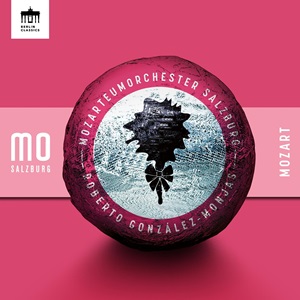
Wolfgang Amadeus Mozart (1756-1791)
Serenade No 6 in D major, K. 239 ‘Serenata Notturna’
Serenade No 4 in D major, K. 203/189b ‘Serenata Colloredo’
March in D major, K. 237/189c
Mozarteumorchester Salzburg/Roberto González-Monjas
rec. 2021, Orchesterhaus des Mozarteumorchesters, Salzburg, Austria
Berlin Classics 0302997BC [54]
Wolfgang Amadeus Mozart wrote the three-movement Serenade No 6 in D major ‘Serenata notturna’, K. 239, during January 1776 in Salzburg. The instrumentation comprises four soloists (two violins, viola, and double bass) and a string orchestra with timpani. Roberto González-Monjas, violinist and conductor on the present recording, states in the booklet that the soloists are virtuosos, while the second group of strings imitate and accompany rudimentarily. The opening movement (‘Marcia. Maestoso’) contains contrasts between the solo voices and tutti, notably the two-bar sections for timpani and pizzicato strings. Other salient features of this serenade include a trio for the solo quartet in the ‘Menuetto – Trio’ and a ten-bar adagio in the ‘Rondeau. Allegretto’ finale. The conductor’s participation as a violinist, as Mozart himself probably would have done, makes the performance sound especially engaging. Musicians from the Mozarteumorchester provide clear musical lines and a tonal beauty that will be palatable even to lovers of large-scale Mozart.
Written in August 1774, the Serenade No 4 in D major, K. 203/189b, was intended for graduation ceremonies at the Benedictine University and is nicknamed after Mozart’s patron, Count Hieronymus von Colloredo. On this recording, the March in D major, K. 237/189c, introduces the eight-movement serenade. As with the previous work, González-Monjas directs from the violin a group of musicians exactly as stipulated in the score: two oboes (flutes), bassoon, two horns, two trumpets, and strings. The violin is prominent in the second, third, and fourth movements. It is advantageous that the conductor plays the solos to lend the proceedings a sense of the solo instrument emerging from the musical texture, rather than a star performer stepping forward to play a concerto.
The booklet contains informative introductory notes in German and English, and the cover evokes a ‘Mozartkugel’ from Salzburg. With rich, detailed sonics in an acoustic that has the right amount of resonance, this disc is well worth acquiring, even by collectors who already own period- and/or modern-instrument performances of these two serenades. These vibrant performances combine historically-informed scholarship (i.e., instrumental forces corresponding to those prescribed by the musical texts, minimal vibrato, and transparency) with playing that exudes a kind of joy akin to how university graduates and other listeners must have felt when they heard these serenades in the mid-1770s.
The popular ‘Serenata notturna’ receives much more attention than the ‘Serenata Colloredo’ does, I suspect, because recordings of the latter tend to be placed in the middle of large collections. This release from Salzburg will hopefully raise awareness of a work that shows the 18-year-old Mozart’s individual voice and prowess as a violinist.
Daniel Floyd
Buying this recording via a link below generates revenue for MWI and helps us keep free access to the site




















